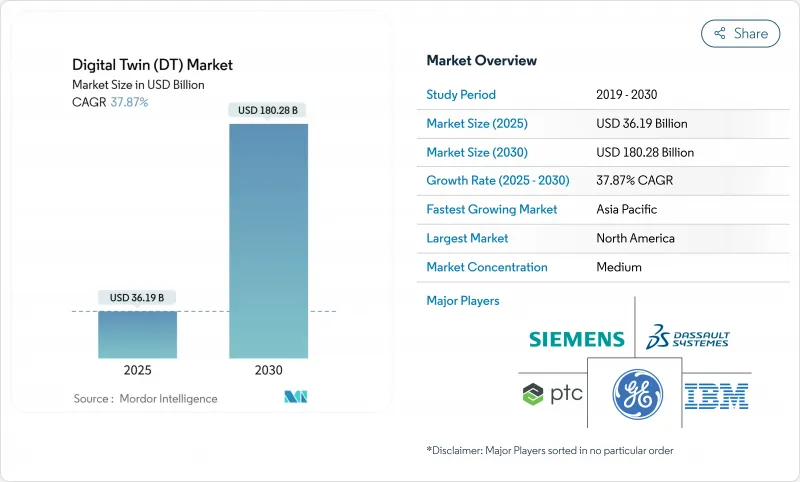
|
市場調査レポート
商品コード
1851796
デジタルツイン(DT):市場シェア分析、産業動向、統計、成長予測(2025年~2030年)Digital Twin (DT) - Market Share Analysis, Industry Trends & Statistics, Growth Forecasts (2025 - 2030) |
||||||
カスタマイズ可能
適宜更新あり
|
|||||||
| デジタルツイン(DT):市場シェア分析、産業動向、統計、成長予測(2025年~2030年) |
|
出版日: 2025年07月02日
発行: Mordor Intelligence
ページ情報: 英文 135 Pages
納期: 2~3営業日
|
概要
デジタルツイン市場は現在、2025年に361億9,000万米ドル、2030年には1,802億8,000万米ドルに達し、CAGR 37.87%で成長すると予測されています。

追い風には、産業用IoTプラットフォームの成熟、エッジAIの幅広い展開、セーフティクリティカルなインフラに対する規制要件などがあります。製造業は、確立されたスマートファクトリー投資のおかげで最大のアプリケーションであり続ける一方、石油・ガスは、生産者が厳しい操業条件下での資産統合性の向上を求めているため、最も強い成長を示しています。地域別では北米がリードを保っているが、中国、インド、日本の公共プログラムが大規模なデジタル化に向けて資金を投入しているため、アジア太平洋が差を縮めています。現在、ほとんどの支出はソリューションが占めているが、企業が統合の専門知識を求めているため、サービスは急速に拡大しています。クラウドの導入はオンプレミスを上回るペースで伸びており、遠隔データ管理の安全策や拡張性の高いアーキテクチャに対する信頼が高まっていることを示しています。サイバーセキュリティのギャップと物理ベースのモデリング人材の不足は、採用の主要な軌道を変えてはいないもの、成長の見通しを弱めています。
世界のデジタルツイン(DT)市場の動向と洞察
産業用IoTプラットフォームの急成長
IIoTの広範な導入は、デジタルモデルを工場現場と同期させるリアルタイムデータを供給します。シーメンスは、Xceleratorエコシステムの強みを生かし、2024年のデジタルビジネス売上高を22%増の90億ユーロ(97億2,000万米ドル)と報告しました。ハネウェルのForgeプラットフォームは、毎日30億以上のデータポイントを処理し、顧客工場の計画外ダウンタイムを35%削減しました。OPC UAやMQTTのような標準化されたプロトコルは、統合の摩擦を減らし、プラントが数ヶ月ではなく数週間でツインを展開することを可能にします。その結果、着実なコスト回避、迅速な根本原因分析、より予測可能なキャパシティプランニングが可能になります。
デバイスレベルでのエッジ/AI推論の拡大
アナリティクスをクラウドからエッジに移行することで、レイテンシーを削減し、データ主権を維持します。マイクロソフトとシーメンスは、資産で推論を実行するIndustrial Foundation Modelsを共同開発し、異常検知のためのミリ秒レベルの応答を可能にしました。アウディは現在、実際の製造ラインのサイクルタイムを最適化するツインをエッジに配置し、仮想PLCを運用しています。また、上流に移動するデータは例外的であるため、ローカルシミュレーションによって帯域幅の消費も制限されます。特殊化されたチップとコンテナ化されたランタイムは、Tier2サプライヤーの導入コストをさらに削減し、バリューチェーン全体にAI対応ツインの普及を加速します。
IT/OTスタック全体にわたるサイバー・フィジカル・セキュリティの脆弱性
スペイン国立サイバーセキュリティ研究所は、ITとOTの橋渡しをするツインが攻撃対象領域を広げ、プロセスコントローラをデータの完全性に関する脅威にさらすと指摘しています。最近のランサムウェア事件では、ツイン・データ・レークを浄化する間、製造業は数日間の生産停止を余儀なくされました。企業がゼロトラストアーキテクチャを統合し、スタッフを訓練するために、平均18ヶ月の導入遅延が発生しています。マルチテナント型ツインは、パートナーからのアクセスを、コラボレーションを遅らせずにセグメント化する必要があるため、複雑さを増しています。
セグメント分析
製造業は、組み込み型IIoTセンサー、予知保全プログラム、継続的改善文化により、2024年のデジタルツイン市場の35.8%を占める。自動車工場やエレクトロニクス工場では、ラインレベルのツインを導入してタクトタイムの変動や品質・歩留まりパターンを分析し、スクラップ率を2桁削減しています。エネルギー効率の向上は、特に資源集約的な冶金やセメント事業において、もう一つの投資回収層を追加します。この業界は、他の業界が追いついてきても、量的優位性を維持し、着実に拡大すると予想されます。
石油・ガスは、現在では規模が小さいもの、オフショア事業者が遠隔検査と故障切り分け機能を必要とするため、2030年までCAGR 29.3%で成長すると予測されます。上流部門では、地震データと生産ログを統合した貯留層ツインを導入し、エンジニアがリグを動員する前に坑井掘削のシナリオをシミュレーションできるようにしています。中流企業ではパイプラインの漏水検知にツインを適用し、シェルのような下流の製油所では、DNV基準で検証されたツインを使用することで、予定外のダウンタイムが20%削減されたことを記録しています。政府の脱炭素化目標は、ツインがフレアの最小化と熱統合戦略を最適化するため、採用をさらに推進します。両分野において、AIによるシナリオテストは、ツインをモニタリングから意思決定支援システムへと昇華させ、総導入台数におけるシェアを強化しています。
ソリューションカテゴリー(ソフトウェアプラットフォーム、物理エンジン、コネクテッドハードウェア)は、2024年の支出額の63.6%を占め、各社が中核となる機能を獲得しています。ベンダーはモデリング・ライブラリと可視化エンジンをバンドルし、プロセス・エンジニアがゼロからコーディングすることなくレプリカを作成できるようにしています。ライセンシング・モデルは、消費ベースのティアへと移行しており、ティア2のサプライヤー間のアクセスを広げています。
しかし、サービスの規模はCAGR 31.4%で急速に拡大しています。インプリメンテーションコンサルタントは、データパイプラインを調整し、セマンティックモデルを作成し、シミュレーションの忠実度を検証します。マネージドサービス契約は、ツインの健全性指標を監視し、パッチを適用し、アルゴリズムのドリフトを調整します。ロールスロイスのTotalCareは、ツインアナリティクスに裏付けされたエンジンのアップタイムを保証します。成果ベースの契約が普及するにつれて、サービスパートナーは、請求可能な時間ではなく、効率性の向上に料金を関連付けることで、より多くのリスクを負うことになります。このモデルは顧客ロイヤリティを強化し、プラットフォームの継続的な強化を促します。
デジタルツイン市場レポートは、用途別(製造、エネルギー・電力、航空宇宙・防衛、石油・ガス、自動車、その他)、コンポーネント別(ソリューション/プラットフォーム、サービス)、導入形態別(オンプレミス、クラウド)、企業規模別(大企業、中小企業)、地域別に分類されています。
地域分析
北米は、インダストリー4.0の早期展開、航空宇宙分野の広範なプログラム、産業向けSaaSへの旺盛なベンチャー資金調達が牽引し、2024年のデジタルツイン市場収益の38.4%を占めました。米国の航空規制当局がシミュレーションベースの認証を受け入れたことで、航空機OEMやTier-1サプライヤの間でツインへの投資が広がっています。カナダと米国のエネルギーメジャーは、環境政策の強化に合わせて、メタン漏れ率を削減するためにパイプラインとLNGターミナルにツインを導入しています。成熟したサイバー保険フレームワークと標準化されたデータ保護義務により、クラウドの採用は特に好調です。
アジア太平洋地域のCAGRは27.2%と最も高く、政府の大型プロジェクトに支えられています。中国のデジタル・チャイナ建設計画では、新しいインフラに都市部のデジタル・ツインが義務付けられており、国内外のベンダーに大規模な調達パイプラインが形成されています。インドのサンガム・デジタルツイン計画では、6Gへの対応に向け、全国的な電気通信のアップグレードにネットワークツイン機能が統合されます。日本のNTTデジタル・ツイン・コンピューティング・イニシアチブは、交通機関や災害対応アルゴリズムに供給する都市規模のレプリカを支援しています。韓国とシンガポールは、リアルタイムのカーボンフットプリント追跡を重視し、スマート工場とスマート港湾のパイロット事業を推進しています。この地域はサプライチェーンの中心的役割を担っているため、ここで学んだ教訓は世界のOEMに迅速に伝搬します。
欧州は、規制上の要請が中心となって着実に前進しています。デジタル・プロダクト・パスポートは、メーカーに製品ライフサイクル全体にわたるトレーサビリティの組み込みを強制し、大量生産品には事実上ライトウェイト・ツインが必須となっています。ドイツのPlattform Industrie 4.0は、標準化された管理シェルガイドラインを提供し、中小企業の統合オーバーヘッドを削減します。フランスは海軍建造の競争力を維持するためにバーチャル造船所ツインに投資し、北欧はネットゼロコードを満たすためにビルディングツインを使用しています。UAEとサウジアラビアは、大規模な拡張に先立ち、効率性と持続可能性のメリットを求めて、油田ツインとギガ・プロジェクト都市ツインを試験的に導入しています。
その他の特典:
- エクセル形式の市場予測(ME)シート
- 3ヶ月間のアナリストサポート
よくあるご質問
目次
第1章 イントロダクション
- 調査の前提条件と市場の定義
- 調査範囲
第2章 調査手法
第3章 エグゼクティブサマリー
第4章 市場情勢
- 市場概要
- 市場促進要因
- 産業用IoTプラットフォームの急成長
- デバイスレベルでのエッジ/AI推論の拡大
- セーフティ・クリティカルなインフラのデジタル化を進める資産集約型産業への規制強化
- ブラウンフィールドプロジェクトのCAPEXを削減する仮想試運転の需要
- リアルタイムの資産レプリカデータを必要とする成果ベースのサービス契約の台頭
- EUと米国におけるデジタル製品パスポートの普及
- 市場抑制要因
- IT/OTスタック全体のサイバー・フィジカル・セキュリティの脆弱性
- 専門分野に特化した物理ベースのモデリング専門家の不足
- 連携ツインで生成されたデータの不透明なIP所有権
- 相互運用性を制限するシミュレーション標準の断片化
- 重要な規制枠組みの評価
- バリューチェーン分析
- テクノロジーの展望
- ポーターのファイブフォース
- 供給企業の交渉力
- 買い手の交渉力
- 新規参入業者の脅威
- 代替品の脅威
- 競争企業間の敵対関係
- 主要利害関係者の影響評価
- 主な使用事例とケーススタディ
- 市場のマクロ経済要因への影響
- 投資分析
第5章 市場セグメンテーション
- 用途別
- 製造業
- エネルギーと電力
- 航空宇宙・防衛
- 石油・ガス
- 自動車
- その他
- コンポーネント別
- ソリューション/プラットフォーム
- サービス
- 展開モード別
- オンプレミス
- クラウド
- 企業規模別
- 大企業
- 中小企業(SMEs)
- 地域別
- 北米
- 米国
- カナダ
- メキシコ
- 南米
- ブラジル
- アルゼンチン
- その他南米
- 欧州
- 英国
- ドイツ
- フランス
- イタリア
- スペイン
- 北欧諸国
- その他欧州地域
- 中東・アフリカ
- 中東
- サウジアラビア
- アラブ首長国連邦
- トルコ
- その他中東
- アフリカ
- 南アフリカ
- エジプト
- ナイジェリア
- その他アフリカ
- アジア太平洋地域
- 中国
- インド
- 日本
- 韓国
- ASEAN
- オーストラリア
- ニュージーランド
- その他アジア太平洋地域
- 北米
第6章 競合情勢
- 市場集中度
- 戦略的動向
- 市場シェア分析
- 企業プロファイル
- ANSYS, Inc.
- AVEVA Group plc
- Bentley Systems, Incorporated
- Cal-Tek S.R.L.
- Cityzenith, Inc.
- Dassault Systemes SE
- General Electric Company
- Hexagon AB
- International Business Machines Corporation
- Lanner Group Limited(Royal HaskoningDHV)
- Mevea Ltd.
- Microsoft Corporation
- Oracle Corporation
- PTC Inc.
- Rescale, Inc.
- Robert Bosch GmbH(Bosch.IO)
- SAP SE
- Schneider Electric SE
- Siemens AG
- Amazon Web Services, Inc.

